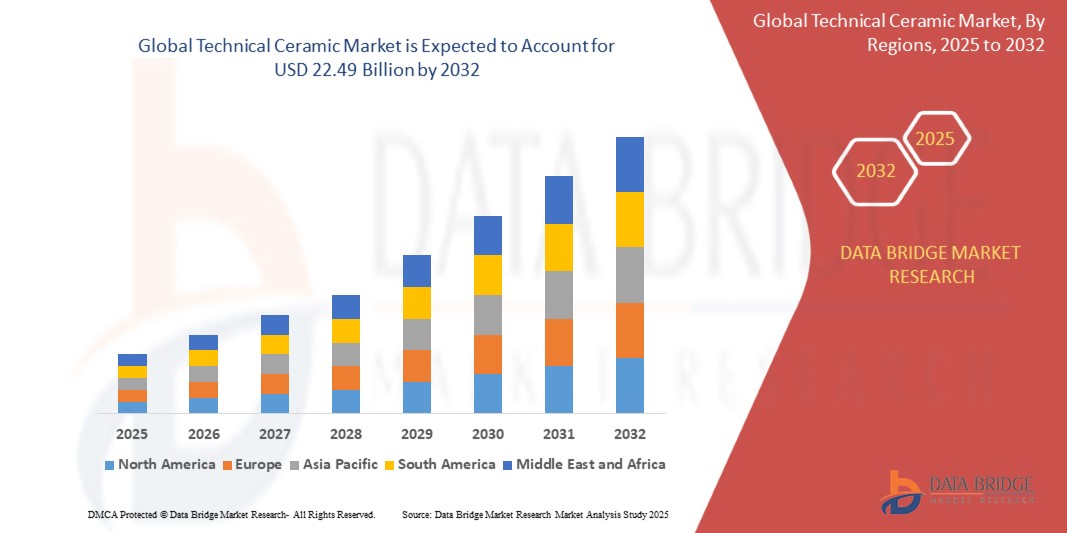Introduction
Technical ceramics represent a class of advanced materials that have transformed numerous industries through their exceptional properties and versatile applications. These engineered ceramic materials, also known as advanced ceramics or fine ceramics, differ significantly from traditional ceramics in their composition, manufacturing processes, and performance characteristics. Technical ceramics exhibit superior mechanical strength, thermal stability, electrical properties, and chemical resistance, making them indispensable in modern technology and industrial applications.
The technical ceramic market encompasses a diverse range of materials including alumina, zirconia, silicon carbide, silicon nitride, aluminum nitride, and various other specialty ceramic compounds. These materials find applications across multiple sectors including electronics, automotive, aerospace, medical devices, energy, and defense industries. The unique combination of properties such as high-temperature resistance, wear resistance, corrosion resistance, and electrical insulation capabilities makes technical ceramics essential for applications where traditional materials fail to meet demanding performance requirements.
The global technical ceramic market has experienced substantial growth driven by increasing demand for high-performance materials in advanced manufacturing processes. Industries are increasingly adopting technical ceramics to enhance product performance, improve operational efficiency, and meet stringent regulatory requirements. The market’s expansion is further supported by continuous technological advancements in ceramic processing techniques, enabling the development of new ceramic compositions and improved manufacturing methods.
The Evolution of Technical Ceramics
The development of technical ceramics traces back to the early 20th century when scientists began exploring the potential of ceramic materials beyond traditional pottery and construction applications. The initial focus was on developing materials that could withstand extreme temperatures and harsh chemical environments. Early applications included electrical insulators, spark plugs, and refractory materials for high-temperature industrial processes.
The 1960s marked a significant turning point in technical ceramic development with the introduction of advanced processing techniques and improved understanding of ceramic microstructure. This period saw the emergence of high-purity ceramic materials and the development of specialized manufacturing processes such as hot pressing, isostatic pressing, and advanced sintering techniques. These innovations enabled the production of ceramics with enhanced density, strength, and reliability.
The electronics revolution of the 1970s and 1980s created new opportunities for technical ceramics, particularly in the development of electronic components and semiconductor applications. The demand for materials with specific electrical properties, thermal conductivity, and dimensional stability drove innovation in ceramic formulations and processing methods. During this period, technical ceramics began finding applications in capacitors, resistors, piezoelectric devices, and various electronic packaging applications.
The 1990s witnessed significant advancements in ceramic matrix composites and nanostructured ceramics. Researchers began incorporating reinforcing phases such as fibers, whiskers, and nanoparticles to enhance mechanical properties and toughness. This period also saw the development of bioceramics for medical applications, opening new market segments for technical ceramic manufacturers.
The 21st century has been characterized by the integration of technical ceramics into emerging technologies such as renewable energy systems, electric vehicles, and advanced manufacturing processes. The development of transparent ceramics, ultra-high temperature ceramics, and multifunctional ceramic materials has expanded the application scope significantly. Recent advances in additive manufacturing techniques have enabled the production of complex ceramic components with intricate geometries previously impossible to achieve through conventional processing methods.
Market Trends Shaping the Technical Ceramic Industry
The technical ceramic market is experiencing several significant trends that are reshaping industry dynamics and creating new opportunities for growth. One of the most prominent trends is the increasing adoption of technical ceramics in the automotive industry, particularly in electric vehicle applications. The transition toward electric mobility has created substantial demand for ceramic components in battery systems, power electronics, and thermal management applications. Technical ceramics provide excellent electrical insulation, thermal conductivity, and chemical stability required for these demanding applications.
Another major trend is the growing emphasis on sustainability and environmental responsibility. Technical ceramics offer superior durability and longevity compared to traditional materials, contributing to reduced maintenance requirements and extended service life. Many industries are adopting technical ceramics as part of their sustainability initiatives, recognizing their potential to reduce environmental impact through improved efficiency and reduced waste generation.
The healthcare sector is witnessing increasing adoption of bioceramics for medical implants, dental applications, and drug delivery systems. The aging global population and increasing healthcare awareness are driving demand for advanced medical devices that utilize technical ceramic materials. Biocompatible ceramics such as alumina, zirconia, and hydroxyapatite are finding widespread applications in orthopedic implants, dental restorations, and various medical devices.
The energy sector is another key driver of technical ceramic market growth, with applications spanning renewable energy generation, energy storage, and power transmission systems. Technical ceramics play crucial roles in solar panels, wind turbines, fuel cells, and energy storage devices. The global push toward clean energy and carbon neutrality is creating substantial opportunities for technical ceramic manufacturers to develop specialized materials for energy applications.
Miniaturization trends in electronics and telecommunications are driving demand for advanced ceramic materials with specific properties such as high dielectric constants, low loss factors, and excellent thermal management capabilities. The development of 5G technology, Internet of Things devices, and advanced computing systems requires ceramic materials that can operate reliably under challenging conditions while maintaining compact form factors.
The aerospace and defense industries continue to be significant consumers of technical ceramics, with applications in engine components, armor systems, and electronic warfare equipment. The increasing focus on lightweight, high-performance materials in aerospace applications is driving innovation in ceramic matrix composites and ultra-high temperature ceramics.
Challenges Facing the Technical Ceramic Market
Despite the promising growth prospects, the technical ceramic market faces several significant challenges that manufacturers and end-users must address. One of the primary challenges is the high cost of technical ceramic materials and components compared to traditional alternatives. The complex manufacturing processes, specialized equipment requirements, and high-quality raw materials contribute to elevated production costs. This cost premium can limit adoption in price-sensitive applications and markets.
Manufacturing complexity represents another significant challenge in the technical ceramic industry. The production of technical ceramics requires precise control of composition, processing parameters, and quality control measures. The inherent brittleness of ceramic materials makes them susceptible to fracture during processing and handling, leading to potential yield losses and increased manufacturing costs. Achieving consistent quality and reliability across large-scale production remains a persistent challenge for many manufacturers.
The limited availability of skilled personnel with expertise in ceramic processing and applications poses a significant constraint on industry growth. Technical ceramics require specialized knowledge in materials science, processing techniques, and application engineering. The shortage of qualified professionals can limit innovation and slow the adoption of technical ceramics in new applications.
Supply chain complexities and raw material availability present ongoing challenges for technical ceramic manufacturers. Many ceramic raw materials are sourced from specific geographic regions, creating potential supply chain vulnerabilities. Price volatility of raw materials can impact production costs and profit margins, particularly for manufacturers operating in competitive markets.
Technical ceramics often face challenges related to joining and assembly with other materials. The different thermal expansion coefficients and mechanical properties of ceramics compared to metals and polymers can create difficulties in creating reliable joints and assemblies. Developing effective joining techniques and compatible material combinations remains an active area of research and development.
The inherent brittleness of ceramic materials presents challenges in applications requiring impact resistance or thermal shock resistance. While technical ceramics offer excellent strength under compression and controlled loading conditions, their performance under dynamic loading or thermal cycling can be limited. This characteristic restricts their use in certain applications where toughness and impact resistance are critical requirements.
Market Scope and Applications
The technical ceramic market encompasses a broad range of applications across numerous industries, demonstrating the versatility and importance of these advanced materials. The electronics and electrical industry represents one of the largest market segments, utilizing technical ceramics in components such as capacitors, resistors, insulators, and semiconductor packages. The superior electrical properties of technical ceramics, including high dielectric strength, low loss factors, and excellent thermal stability, make them essential for modern electronic devices and systems.
The automotive industry has emerged as a significant consumer of technical ceramics, particularly with the increasing adoption of electric vehicles and advanced emission control systems. Technical ceramics are used in oxygen sensors, catalytic converters, brake systems, and engine components. The superior wear resistance, thermal stability, and chemical inertness of technical ceramics make them ideal for these demanding automotive applications.
The medical and healthcare sector represents a rapidly growing market segment for technical ceramics, particularly bioceramics used in medical implants and devices. Ceramic materials such as alumina, zirconia, and hydroxyapatite are widely used in orthopedic implants, dental restorations, and various medical devices. The biocompatibility, wear resistance, and chemical stability of technical ceramics make them suitable for long-term implantation in the human body.
The energy sector offers substantial opportunities for technical ceramic applications, including components for solar panels, wind turbines, fuel cells, and energy storage systems. Technical ceramics provide excellent performance in high-temperature environments, corrosive conditions, and electrical applications common in energy generation and storage systems. The global transition toward renewable energy sources is driving increased demand for technical ceramic materials in energy applications.
The aerospace and defense industries utilize technical ceramics in various applications including engine components, armor systems, radar systems, and electronic warfare equipment. The lightweight, high-strength properties of technical ceramics make them attractive for aerospace applications where weight reduction is critical. The superior performance of technical ceramics under extreme conditions makes them valuable for defense applications.
The chemical processing industry relies on technical ceramics for applications requiring chemical resistance, wear resistance, and thermal stability. Technical ceramics are used in pumps, valves, linings, and other equipment exposed to corrosive chemicals and high temperatures. The chemical inertness and durability of technical ceramics make them suitable for these demanding chemical processing applications.
The cutting tools and wear parts market represents another significant application area for technical ceramics. The superior hardness, wear resistance, and thermal stability of technical ceramics make them ideal for cutting tools, grinding media, and wear-resistant components. These applications benefit from the extended service life and improved performance offered by technical ceramic materials.
Market Size and Growth Projections
The global technical ceramic market has demonstrated robust growth over the past decade and is projected to continue expanding at a significant rate. The market value has grown from approximately $8 billion in 2020 to an estimated $12 billion in 2025, representing a compound annual growth rate of approximately 8-10%. This growth trajectory is expected to continue, with market projections indicating the technical ceramic market could reach $18-20 billion by 2030.
The electronics and electrical segment currently represents the largest market share, accounting for approximately 35-40% of total technical ceramic consumption. This segment is driven by the increasing demand for electronic devices, 5G infrastructure, and advanced computing systems. The automotive segment represents the second-largest market share at approximately 20-25%, with rapid growth expected due to the transition toward electric vehicles and advanced automotive technologies.
The healthcare and medical segment, while currently representing a smaller market share of approximately 15-20%, is experiencing the fastest growth rate due to increasing demand for medical implants and devices. The energy segment accounts for approximately 10-15% of the market, with significant growth potential as renewable energy adoption accelerates globally.
Regional market analysis reveals Asia-Pacific as the dominant market for technical ceramics, accounting for approximately 50-55% of global consumption. This dominance is attributed to the concentration of electronics manufacturing, automotive production, and industrial activities in countries such as China, Japan, and South Korea. North America and Europe represent approximately 20-25% and 15-20% of the global market, respectively, with strong demand from aerospace, defense, and medical applications.
The market growth is supported by increasing investments in research and development, technological advancements in ceramic processing, and expanding applications across various industries. The development of new ceramic compositions, improved manufacturing techniques, and enhanced performance characteristics is expected to drive continued market expansion.
Factors Driving Growth in the Technical Ceramic Market
Several key factors are driving the sustained growth of the technical ceramic market, creating opportunities for manufacturers and spurring innovation across the industry. The increasing demand for high-performance materials in advanced manufacturing processes represents a fundamental driver of market growth. Industries are seeking materials that can withstand extreme conditions, provide superior performance, and offer long-term reliability. Technical ceramics meet these requirements through their unique combination of properties including high temperature resistance, chemical stability, and mechanical strength.
The global trend toward electrification and digitalization is creating substantial demand for technical ceramics in electronic applications. The deployment of 5G networks, development of Internet of Things devices, and advancement of artificial intelligence systems require materials with specific electrical properties, thermal management capabilities, and miniaturization potential. Technical ceramics provide the necessary performance characteristics for these demanding electronic applications.
The automotive industry’s transformation toward electric mobility is generating significant demand for technical ceramics in battery systems, power electronics, and thermal management applications. Electric vehicles require materials that can provide electrical insulation, thermal conductivity, and chemical stability under challenging operating conditions. Technical ceramics offer superior performance compared to traditional materials in these applications.
The growing emphasis on sustainability and environmental responsibility is driving adoption of technical ceramics as environmentally friendly alternatives to traditional materials. Technical ceramics offer extended service life, reduced maintenance requirements, and improved efficiency, contributing to reduced environmental impact. Many industries are incorporating technical ceramics into their sustainability strategies to meet environmental objectives and regulatory requirements.
The increasing adoption of advanced manufacturing technologies such as additive manufacturing, precision machining, and automated assembly is creating new opportunities for technical ceramic applications. These manufacturing technologies enable the production of complex ceramic components with intricate geometries and tight tolerances previously impossible to achieve. The integration of technical ceramics into advanced manufacturing processes is expanding their application scope significantly.
The expanding healthcare sector and aging global population are driving demand for bioceramics in medical applications. The increasing prevalence of chronic diseases, growing healthcare awareness, and advancing medical technologies are creating substantial opportunities for technical ceramic manufacturers in the healthcare market. Bioceramics offer superior biocompatibility, wear resistance, and longevity compared to traditional materials used in medical devices.
The global energy transition toward renewable sources is creating substantial demand for technical ceramics in energy applications. Solar panels, wind turbines, fuel cells, and energy storage systems require materials that can operate reliably under challenging conditions while maintaining high efficiency. Technical ceramics provide the necessary performance characteristics for these energy applications.
The aerospace and defense industries continue to drive demand for technical ceramics through their requirements for lightweight, high-strength materials that can operate under extreme conditions. The increasing focus on fuel efficiency, performance optimization, and mission-critical reliability is driving adoption of technical ceramics in aerospace and defense applications.
Investment in research and development is accelerating innovation in technical ceramic materials and processing techniques. Manufacturers are developing new ceramic compositions, improving manufacturing processes, and enhancing performance characteristics to meet evolving market demands. This continuous innovation is creating new application opportunities and expanding the market scope for technical ceramics.
The development of emerging technologies such as quantum computing, advanced sensors, and next-generation communication systems is creating new demand for specialized technical ceramic materials. These applications require materials with unique properties such as specific electrical characteristics, optical properties, or magnetic behavior. Technical ceramics are being developed to meet these specialized requirements, creating new market opportunities.
Government initiatives and policies supporting advanced manufacturing, clean energy, and technological innovation are providing additional support for technical ceramic market growth. Many countries are implementing policies to promote the adoption of advanced materials, support research and development activities, and encourage innovation in high-technology industries. These initiatives are creating favorable conditions for technical ceramic market expansion.
The increasing integration of technical ceramics into multi-material systems and hybrid components is expanding their application scope. Engineers are developing innovative solutions that combine technical ceramics with metals, polymers, and other materials to create components with optimized performance characteristics. This integration approach is creating new opportunities for technical ceramic applications across various industries.
Other Trending Reports



